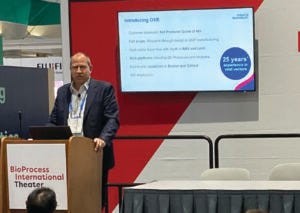- Sponsored Content
Innovation as the Key to Gene Therapy Manufacturing
August 24, 2022
Sponsored by Oxford Biomedica Solutions
 David Backer, chief commercial officer, Oxford Biomedica.
David Backer, chief commercial officer, Oxford Biomedica.
Backer described the business models of Oxford Biomedica and Oxford Biomedica Solutions. The public company, OXB, licenses its technology. It historically has focused on lentiviruses but has moved into AAV. End-to-end capabilities are offered at both the Boston and Oxford sites. The company has grown rapidly because even though it specializes in lentivirus production, it was asked to increase its capabilities to manufacture an adenovirus-vectored COVID-19 vaccine for AstraZeneca as part of a consortium with Oxford University. OXB took that process from 5 L to 1,000 L in GMP production in nine months.
For AAV manufacturing, OXB established a partnership with Homology Medicine. AAVs are known to have low productivity, and manufacturers continue to have regulatory concerns particularly around CMC and product characterization. Backer emphasized the importance of using a process that’s going to give you a pure product. Because overall product quality and the state of the analytics are other areas about which the FDA expresses concern, Backer noted the need for AAV products to be manufactured with purity profiles that will meet expectations for early and late-stage clinical trials.
Boston-based Oxford Biomedica Solutions was established as a partnership with Homology Medicines in which Oxford Biomedica owns 80% of the assets. Homology previously developed a manufacturing template process for AAV, so its facility and technology already were in place for manufacturing GMP products.
Backer outlined more of the company’s capabilities. Through the Homology acquisition have come five successful investigational new drug (IND) applications using a suspension-based transient-transfection process that shows good linearity in scaling from 2 L to 2,000 L. OXB’s four patent families include transfection processes, plasmid systems, purification processes, and a formulation that can be refrigerated rather than needing to be frozen. The facility has one 500-L bioreactor and then a second train with two 500-L bioreactors side by side. So it can pool those to achieve 1,000 liter batches.
One area of innovation is a move from a three-plasmid system to a dual system. With the company’s proprietary technology has come a 230% productivity increase with a high percentage of fully intact vector. The improved packaging of two rather than three plasmids also lowered the percentage of partial vectors. Homology has used an AAV9 family for its products, so OXB is developing that technology further by investigating different serotypes. Backer noted his company’s excitement about achieving high-titer products both in the triple-plasmid and dual-plasmid areas. A number of bioreactor runs in the product development space at 2,000 L were performed to show comparability and linearity. The dual-plasmid system provides both the needed purity and scalability. Backer outlined the company’s product quality and safety analytics.
Lentivirus technology is housed at the Oxford site. Innovations have resulted from vector engineering to increase capabilities and productivity, moving from an adherent process to a batch-suspension process and to a perfusion process, with a fourth process using producer cell lines. The company also is working with producer cell lines for larger-volume products and believes that such cell lines will become the preferred future method. Backer shared information about validating the perfusion system; with addition of the company’s proprietary technologies, it has produced a stable product with higher yields. Some such processes have yielded 30× higher productivity.
Backer described other technologies in use at his company. One is an RNA chaperone, which enhances lentiviral vector production and decreases the particle-to-infectivity ratio. Another is the LentiStable producer cell line. He concluded by emphasizing that specialist companies can and continue to innovate to optimize product-specific applications.
Fill out the form below to view the full BPI Theater presentation.
You May Also Like





